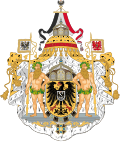German monarchy
| Monarchy of Germany | |
|---|---|
|
Federal
|
|

|
|

William II
|
|
| Details | |
| Style | His Imperial and Royal Majesty |
| First monarch | William I |
| Last monarch | William II |
| Formation | 18 January 1871 |
| Abolition | 9 November 1918 |
| Residence | Stadtschloss, Berlin |
| Appointer | Hereditary |
| Pretender(s) | Prince George Frederick |
The Monarchy of Germany (the German Monarchy) was the system of government in which a hereditary monarch was the sovereign of the German Empire from 1871 to 1918.
The Monarch of Germany was created with the proclamation of the President of the North German Confederation and the King of Prussia, William I of Prussia, as "German Emperor" during the Franco-Prussian War, on 18 January 1871 at the Palace of Versailles.
The title German Emperor was carefully chosen by Minister President of Prussia and Chancellor of the North German Confederation Otto von Bismarck after discussion until (and after) the day of the proclamation. William I accepted this title grudgingly as he would have preferred "Emperor of Germany" which was however, unacceptable to the federated monarchs, and which would also have signalled a claim to lands outside of his reign (Austria, Switzerland, Luxembourg etc.). The title Emperor of the Germans, as had proposed at the Frankfurt Parliament in 1848, was ruled out as he considered himself chosen "By the Grace of God", not by the people as in a democracy.
By this ceremony, the North German Confederation was transformed into the German Empire. This empire was a federal monarchy; the emperor was head of state and president of the federated monarchs (the kings of Bavaria, Württemberg, Saxony, the grand dukes of Oldenburg, Baden, Mecklenburg-Schwerin, Hesse, as well as other principalities, duchies and of the free cities of Hamburg, Lübeck and Bremen).
...
Wikipedia
